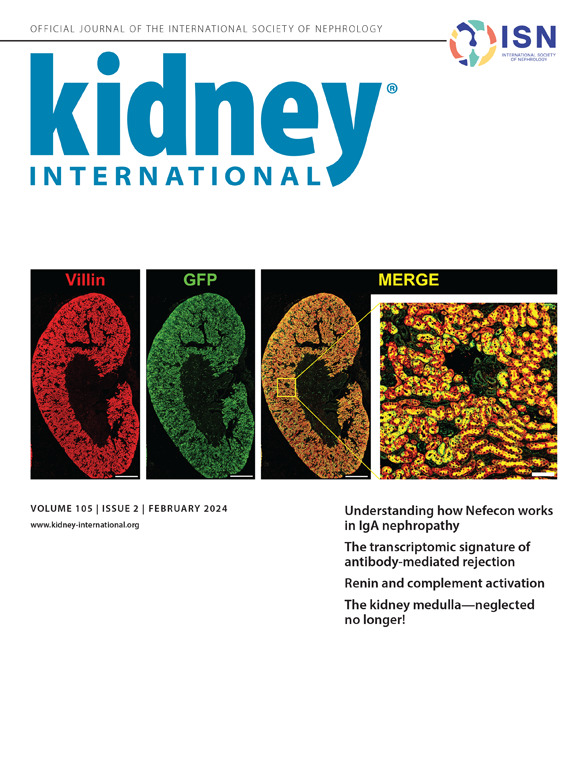一项随机对照试验评估普伐他汀对早期常染色体显性多囊肾病成年患者肾脏疾病结局的影响。
IF 12.6
1区 医学
Q1 UROLOGY & NEPHROLOGY
引用次数: 0
摘要
普伐他汀治疗是否能减轻成年早期常染色体显性多囊肾病(ADPKD)患者的肾功能障碍尚不清楚。为了回答这个问题,我们对150名ADPKD患者(52名男性和98名女性,25-60岁)进行了一项前瞻性、随机、对照、双盲临床试验,估计肾小球滤过率(eGFR)为每1.73m2 60 ml/min或更高。方法随机分配患者接受40 mg普伐他汀或安慰剂治疗2年。主要终点是身高调整总肾容积(HtTKV)的年变化。次要结果是磁共振血管造影肾血流的年变化和GFR (mGFR)的年变化。结果在随机分组的参与者中,安慰剂组和普伐他汀组HtTKV中位数(四分位数范围)的年增长率分别为3.1%(1.4,6.8)和4.3%(3.0,6.6)。肾血流量年下降率(ml/min / 1.73m2)安慰剂组为-32.7(-62.1,-0.8),普伐他汀组为-15.1(-50.7,14.4)。安慰剂组mGFR (ml/min / 1.73m2)的中位变化为-2.3(-5.1,1.6),普伐他汀组为-1.4(-6.4,2.0)。总的来说,治疗组之间没有明显的参数差异。在疾病进展较快的患者中也有类似的趋势(Mayo Imaging分级为1C、D和E)。结论在ADPKD和保留肾功能的成人患者中,与安慰剂相比,普伐他汀没有减缓HtTKV的增加,也没有减缓肾血流量和肾功能下降的作用。本文章由计算机程序翻译,如有差异,请以英文原文为准。
A randomized controlled trial evaluated the effect of pravastatin on kidney disease outcomes in adult patients with early-stage autosomal dominant polycystic kidney disease.
INTRODUCTION
Whether treatment with pravastatin mitigates kidney dysfunction in adult patients with early autosomal dominant polycystic kidney disease (ADPKD) is unknown. To answer this, we performed a prospective, randomized, controlled, double-blind clinical trial in 150 patients (52 males and 98 females; 25-60 years) with ADPKD, and an estimated glomerular filtration rate (eGFR) of 60 ml/min or more per 1.73m2.
METHODS
Patients were randomly assigned to receive 40 mg of pravastatin or a placebo for two years. The primary outcome was the annual change in height-adjusted total kidney volume (HtTKV). Secondary outcomes were the annual change in kidney blood flow by magnetic resonance angiography and the annual change in measured GFR (mGFR).
RESULTS
Among the participants who underwent randomization, the annual rate of increase in HtTKV median (interquartile range) was: 3.1% (1.4, 6.8) in the placebo and the pravastatin 4.3% (3.0, 6.6) group. The annual rate of decline in kidney blood flow (ml/min per 1.73m2) was -32.7 (-62.1, -0.8) in placebo vs. -15.1 (-50.7, 14.4) in the pravastatin group. The median change in mGFR (ml/min per 1.73m2) -2.3 (-5.1, 1.6) for placebo and -1.4 (-6.4, 2.0) for the pravastatin group. Overall, no parameter differed significantly between treatment groups. There was a similar trend in patients with faster disease progression (Mayo Imaging Class 1C, D, and E).
CONCLUSIONS
Among adult patients with ADPKD and preserved kidney function, pravastatin did not slow the increase in HtTKV and had no effect on slowing the decline in kidney blood flow and kidney function compared to placebo.
求助全文
通过发布文献求助,成功后即可免费获取论文全文。
去求助
来源期刊

Kidney international
医学-泌尿学与肾脏学
CiteScore
23.30
自引率
3.10%
发文量
490
审稿时长
3-6 weeks
期刊介绍:
Kidney International (KI), the official journal of the International Society of Nephrology, is led by Dr. Pierre Ronco (Paris, France) and stands as one of nephrology's most cited and esteemed publications worldwide.
KI provides exceptional benefits for both readers and authors, featuring highly cited original articles, focused reviews, cutting-edge imaging techniques, and lively discussions on controversial topics.
The journal is dedicated to kidney research, serving researchers, clinical investigators, and practicing nephrologists.
 求助内容:
求助内容: 应助结果提醒方式:
应助结果提醒方式:


